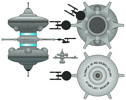 |
 |
Introduction to the Museum
![]() Foreword by the Director
Foreword by the Director![]()
The Starfleet Museum was established in 2213 with the goal of preserving historically important Starfleet vessels for future generations. Because of the rapid pace of technologic advance, older ship types are usually stripped and broken up or sold to local defense forces soon after more modern vessels enter service. Maintenance costs and the need to stock outmoded replacement equipment limit the use of older ships in even auxiliary roles. As a result, by 2211 many famous Starfleet vessel classes were believed lost forever. However, a Federation-wide appeal for retired Starfleet vessels was begun that year, the 50th anniversary of Starfleet's founding, by the Starfleet Association, an organization of retired and active duty Starfleet personnel and supporters of Starfleet. In 2218, the Starfleet Museum received a Federation Council Charter and was opened near Starfleet Headquarters in San Francisco, Earth, Sol. Our Orbital Annex was officially opened the following year and now houses more than 50 historically important vessels.

Starfleet Museum Orbital Annex
Ships have come to the Starfleet Museum in many ways. Some early ships were retrieved from remote corners of the galaxy. In 2274, USS Carolina (NCC-160), a Daedalus-class cruiser, was found welded to an asteroid in the Xii system, where it had become a habitat module for colonists. In 2291, the Paris-class light cruiser USS Damascus (NCC-910), which was not thought capable of planetary landings, was found on the surface of Pashran IV. The ship had been decommissioned and sold for scrap in 2206; how and when it came to be on the surface of such a distant planet is not known. Other ships are given by private collectors, such as Mr. Flint of Holberg 937G, who donated a fully-restored Archer-class patrol craft (UES DelCampo, PC-76) upon his death in 2312. Occasionally, historically important ships are saved from the breaking-yard torch: the Wasp-class cruiser USS Kearsarge (NCC-226), after a long career with Starfleet, Transport Command, and commercial services, was literally minutes from this sad fate when she was purchased for the weight of her materials. In addition, the Starfleet Museum will obtain vessels from other public and private museums and collections by purchase or trade: the UES Stingray (CEM-6, Torsk class) came to us in this way. Still other ships, like USS Enterprise (NCC-1701-A, Enterprise class), are presented to the Museum by the Chief of Starfleet Operations after long and illustrious careers. Several ships of belligerent powers captured in combat have come to the Museum after being examined by Starfleet's Bureau of Technology Assessment: IKS Qel'Poh, the Klingon "Bird of Prey" captured by Admiral James T. Kirk in orbit of the Genesis Planet, has been a popular attraction at the Museum since 2294. The Federation occasionally receives requests from the original owners to return these ships.
The Starfleet Museum attempts to restore the exterior surfaces, and, if possible, the bridge, of all ships to service specifications. However, for safety reasons, on-board systems are powered by photovoltaic cells, no antimatter is kept on board, and the matter/antimatter reactors are never brought on line. Because of the airless, gravity-free environment of space, the ships are perfectly preserved with little or no maintenance. USS Kongo (NCC-1716), a representative of the fabled Constitution class, is the only ship that is routinely brought up to full fusion power to orbit the Earth once a year as part of Federation Day festivities.
In addition to the vessels in the Orbital Annex, hundreds of historical artifacts tracing the history of manned space flight are on display at the Main Museum Complex. These include historic aircraft and smaller spacecraft, uniforms, weapons, equipment, and documents from the 1950s to the present. In addition, bridge modules from several famous ships are on display. For the enjoyment of visitors, holodecks can be used to simulate famous missions and battles of Starfleet vessels.
The Starfleet Museum invites you to pay a visit the next time you are in the Sol system. Open every day (except Federation holidays) 0800-2000 San Francisco time. Admission free. Museum shop and cafeteria open 0800-2000. Free transporter service to the Orbital Annex is available from the Main Museum Complex. Scholars should contact us for information regarding access to our special research collection. (Com: STFL.LNX 0117-042 720-5460)
I am sure you will enjoy your stay.
Yours sincerely,
Masao Okazaki, Director, Starfleet Museum
![]()